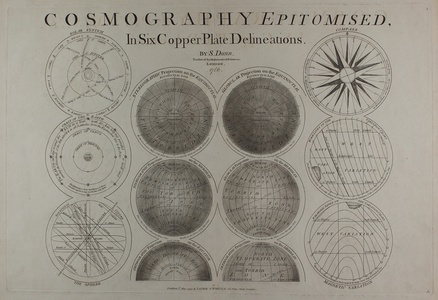| Method | Copper engraved |
| Artist | Dunn, Samuel |
| Published | By S. Dunn, London, 1786. Published 12th May 1794 by Laurie & Whittle, 53 Fleet Street London. |
| Dimensions | 357 x 443 mm |
| Notes |
A series of illustrations demonstrating various cosmographic principals, from the 1794 Laurie & Whittle printing of Samuel Dunn's 'A New Atlas of the Mundane System; or, of Geography and Cosmography: Describing The Heavens and the Earth, The Distances, Motions and Magnitudes of the Celestial Bodies: The Various Empires, Kingdoms, States, Republics; and Islands, throughout the Known World.' The plate contains 12 projections, 10 circles and 2 semicircles, explaining the Orbits of the Solar System, the Orbit of the Earth, the Solstices and Equinoxes, the Points of the Compass, Worm Lines and Parabolic Lines of Magnetic Variation, and Stereographic, Globular, and Orthographic Projections on the Equinoctial, Equatorial, and Meridian. Samuel Dunn's 'New Atlas of the Mundane System' was a popular contribution to celestial cartography in the late seventeenth-century. The work contained six celestial charts, four of which were cosmographical. These maps elucidated subjects such as the size and distance of the sun and planets, time as it relates to latitude, and orthodromic diagrams. Samuel Dunn (d.1794) was a British mathematician and astronomer. Dunn was believed to have been born in Crediton, Dorset, though the year is not known. He rose to fame in the 1750's when he began to prolifically author books, maps, and charts. Many of these works were reproduced in contemporary atlases and encyclopedias. Dunn ran an astronomical academy in Ormond House, which is where he observed the famous transit of Venus in 1761. He was a member of the American Philosophical Society, and was also employed by the East India Company. His best known works were a series of wall maps of the World and Continents, published by Sayer and Laurie & Whittle, as well as his 'New Atlas of the Mundane System.' Robert Laurie (c.1755-1836) was a British engraver, mezzotint artist, and publisher. In 1776, he was awarded a prize by the Society of Arts for the invention of a method of producing colour-printed mezzotints. Laurie succeeded the publisher Robert Sayer after the latter's death in 1794, and, in partnership with James Whittle, continued Sayer's prolific and well-established business on the Fleet Street, issuing prints, maps, illustrated books, charts, and nautical works. Following Laurie's retirement in 1812, Whittle continued in business with his former partner's son, Richard Holmes Laurie, who gained sole ownership of the business in 1818 with the death of Whittle. Condition: Central vertical fold, as issued. Tears to bottom of central fold and to top right margin, without loss to plate. Minor time toning to margins. Blank on verso. |
| Framing | unmounted |
| Price | £300.00 |
| Stock ID | 50638 |

